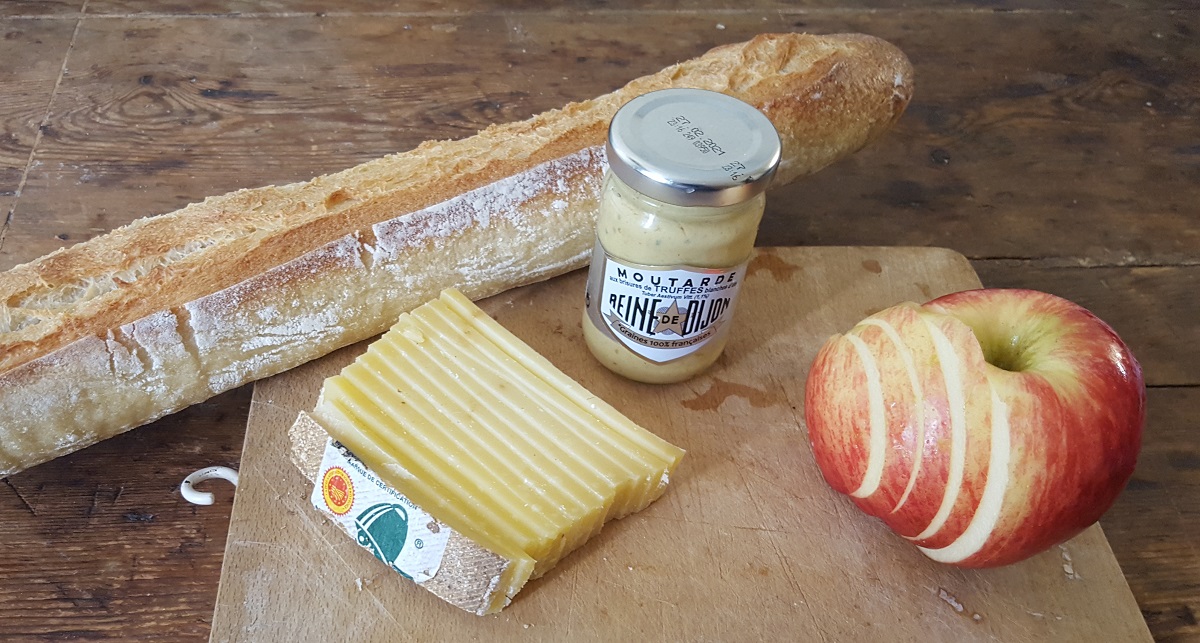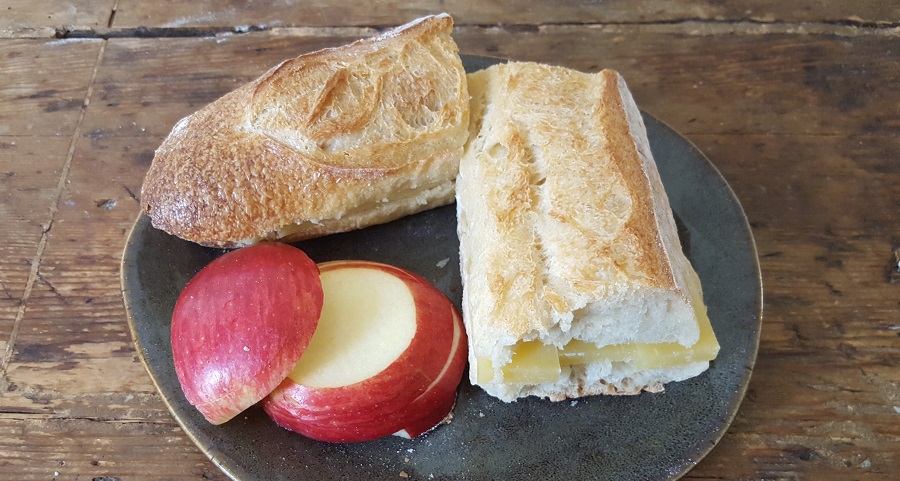
There was a time in my neighborhood, years ago, when picnicking meant bringing together fruits, salads, pâtés, cheeses, sausages, hams and a decent bottle of wine. Some would bring blankets, and occasionally I’d see a well-packed wicker picnic basket. There were plastic forks, knives and cups. There were paper plates and always one good knife. And here and there, within the collective hum of canal-side conviviality, I’d hear metal cutlery against earthenware plates. Now, it’s mostly potato chips and beer, unless someone has made the minimal effort to buy a pizza. Occasionally, several women might share cherry tomatoes and plastic-wrapped precut fruit. Among the hundreds of people who will sit along a 500-yard stretch the canal on any given evening, none is picnicking. They are all meeting for a drink.
So here is one way to re-raise the culinary bar with a summer sandwich recipe.
The ingredients
1. A traditional baguette, up to one half per person.
2. Comté cheese aged 18 months, 100-150 grams (3.5-5.3 ounces) per person.
3. Mustard with truffles, up to one teaspoonful, to taste, per person.
The traditional baguette
Formally called une baguette de tradition française, un pain traditionnel français, or un pain traditionnel [de France], and colloquially known as une tradition [s’il vous plait], the make-up of a traditional baguette is defined by a governmental decree of 1993. It must contain only wheat flour, water and salt, along with yeast, with tolerance for very limited amounts of other flours. Plenty of other delicious breads, including non-traditional baguettes and other loaves may also be tried with this recipe if you don’t have a baker of excellent traditional baguettes nearby. However, a traditional baguette is best.
While the proper portion of tender crumb (mie) to cracking crust (croûte) is important for any baguette, I prefer for this recipe a traditional baguette on the slightly white (blanche, meaning less baked) side of the spectrum, as opposed to the crustier more baked (cuite) version. In any case, it should remain within the mid-range, neither too blanche nor too cuite. It is essential that the baguette not be over 3 hours old, otherwise toasting in required. If there are several bread bakers within reach of your grocery rounds, it’s advisable to decide upon the best maker of traditional baguettes before attempting this recipe. Your stick of bread should also be kindly served at the bakery; a fine-looking baguette from an unkind seller may contain traces of bad karma. (Within my shopping radius, the prize baguette is found at 58 rue de Lancry in the 10th arrondissement.)
A single baguette feeds two for an adult’s lunch where this sandwich is the principal “dish.” For those who like figures, count two-fifths to four-ninths of a baguette per sandwich. That leaves a small portion which may have already been eaten on the way from the bakery anyway.
The cheese
This recipe calls for a semi-hard raw-milk cow cheese with a sharpness that is present yet not overly pronounced. My preference is for a Comté cheese aged 18 months. Comté is the most popular cheese in France. Produced in 80-pound wheels, three feet in diameter, then aged in the area of its production for four months to four years, Comté comes from the Jura Massif, a sub-alpine range along the French-Swiss border. We are naturally on the French side with this sandwich, in the Bourgogne-Franche-Comté region for the most part. (Some Comté also produced in Ain, on the northern edge of the Auvergne-Rhône-Alpes region). The Montbéliarde breed of cow is the primary source (95%) of milk for Comté, while 5% of the overall herd is comprised of the Simmental breed.
Much of the production is placed on the market after less than 12 months in the maturing cellars. However, those younger Comté risk being overwhelmed by the mustard with truffles in this recipe, while older Comtés aged 24 months or more stand best on their own. A 15-month Comté may do, but at 18 months there’s an ideal balance between its nuttiness and its saltiness, a saltiness that becomes more pronounced with ageing. (Note: What may appear to be salt in older Comtés of 18 months and more are in fact cheese crystals, as one might find in older Parmesans). Together, the nuttiness and the saltiness at 18 months further balance well with the mustard with truffles. Learn about Comté aging in this video.
I’ve also tried this recipe with a flavorful sheep cheese, such as a Tomme Corse, from Corsica, aged close to one year, and found it quite interesting. I’ve also experimented with a Brie de Melun (not Brie de Meaux), from just east of Paris, aged 10 weeks, and enjoyed that as well, though I prefer for this recipe a cheese with a semi-hard texture. In a pinch, when French cheese isn’t available, Comté can be replaced by an aged sharp cheddar. In any case, this is an element of the recipe that’s worth playing with according to your taste and the availability of various cheeses. Just be sure to select a gracefully aged cheese with a pronounced but not stinky taste on its own.
The mustard
The Romans of Antiquity were likely the first mustard makers in Europe, but the international conquest of the condiment comes from the appetite of the Dukes of Burgundy during the Middle Ages, particularly from their duchy’s capital in Dijon. Hence the reputation of Dijon in your own lifetime, more than 600 years later.
Dijon mustard (which isn’t necessarily from Dijon and might better be thought of as Dijon-style mustard) is prepared with dark mustard seeds, which have a sharper bite than the mild yellow (actually, yellow-white) variety. The English language gets the word mustard from the Old French moustarde (moutarde in Modern French). Mustum (Latin)/ moût (French)/ must (English) refers to the grape juice or young wine that was added to the grains to create the mustard paste.
Nowadays, 70% of French-made Dijon mustards use grains from Canada, but the jar used in this recipe contains only grains from Burgundy, administratively part of the Bourgogne-Franche-Comté region.
My mustard of choice for this summer sandwich is one with bits of white summer truffles, moutarde aux brisures de truffes blanches d’été. Specifically, a limited-edition product made by Reine de Dijon, a company based just outside of Dijon. The truffles in question are tuber aestivum, at 1.1%—a small but potent percentage. Use sparsely but markedly, enough to reach the nose when you first pick up your sandwich but not enough to overwhelm the bread and the cheese. The amount is key so as not to upset the proper balance of this sandwich. Do not feel that you have to cover every nook and cranny of the mie (crumb) of the bread. If this is your first time using truffled mustard then you may want to take a test run on with the nib of the baguette. (I will not at this time discuss the debate within the culinary community in France as to whether it should be placed on the bottom or top portion of the sliced baguette.)
Edmond Fallot, another regional mustard house (moutarderie), which can be visited in Beaune, the main town just south of Dijon, makes what might be considered a more precious mustard using fall-winter truffles (truffe de Bourgogne, tuber uncanitum, 5%). However, that mustard is more appropriately served with grilled meats or rabbit, or perhaps integrated into a homemade mayonnaise for other dishes, rather than used as a delicate condiment for this summer sandwich. (I could well imagine either mustard properly dosed to add a kick to a sandwich of raw roast beef, with or without cheese, and leave you to experiment with that at home.)
Maille, the most internationally known Burgundy-based mustard producers, also makes a line of truffled mustards.
No other condiments are needed.
How to serve
Cut in half. Best when served with fruit or salad. Avoid serving with potato chips (though I understand the temptation). This summer sandwich should be served soon after preparation.
Suggested wine
Côtes de Jura vin jaune, a deep yellow wine, as the name indicates, from the same region as the Comté cheese. I’ve also had a delightful experience in pairing with this dish a 100% pinot meunier brut champagne, which has the advantage of serving as the aperitif as well.
See this video for other wine and Comté pairing ideas and this video for other dishes with Comté.
© 2020, Gary Lee Kraut.



Gary
Excellent insight on a picnic…informative, from such a good source – well written – the bread, cheese, mustard, etc., the style!
Cheers!
Thank you,
Peter
Thanks, Peter.
A pleasure to have a reader who saw my “recipe” for what it was intended to be.
Gary
Excellent and informative, Gary! Bravo!